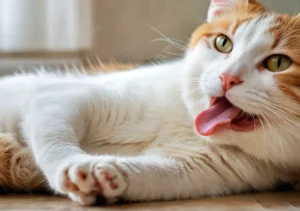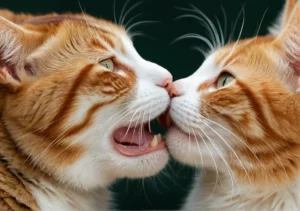Have you noticed your cat’s whiskers are a strange yellow color? Let’s uncover the reasons behind this unusual phenomenon.
Many people may wonder why their cat’s whiskers are yellow. The yellowing of a cat’s whiskers can be caused by a variety of factors, including natural oils, environmental factors, or even health issues. Let’s explore this further:
Natural Oils and Grooming Habits
Have you ever noticed your cat’s whiskers taking on a yellow hue? Don’t worry, it’s not uncommon! One reason for this discoloration could be the natural oils produced by your feline friend’s skin. Cats groom themselves by licking their fur, distributing these oils all over their body, including their whiskers. Over time, these oils can build up and cause the whiskers to appear yellow.
If your cat has a meticulous grooming routine and loves to keep their fur spotless, this could be a contributing factor to the yellowing of their whiskers. The constant licking and grooming can transfer these oils to the whiskers, leading to the change in color.
To help minimize this effect, you can gently clean your cat’s whiskers with a damp cloth regularly. This can help remove any excess oils and dirt, keeping their whiskers looking clean and fresh. Additionally, ensuring your cat has a balanced diet and good overall health can also contribute to healthier-looking whiskers.
Environmental Factors
Aside from natural oils, environmental factors can also play a role in causing your cat’s whiskers to turn yellow. Exposure to smoke, dirt, or certain chemicals can all contribute to this discoloration. If your cat spends time in a smoky environment or loves to explore dusty spaces, their whiskers may be more prone to staining.
To combat this, consider creating a clean and smoke-free environment for your cat to live in. Regularly dusting and vacuuming your home can help reduce the amount of dirt and particles that can accumulate on your cat’s whiskers. You can also ensure your cat has access to clean water to drink, as hydration is key to maintaining healthy skin and whiskers.
In addition, be mindful of the cleaning products you use around your cat. Opt for feline-friendly products that won’t irritate their skin or contribute to yellowing whiskers. By taking these precautions, you can help keep your cat’s whiskers looking their best.
Diet and Nutrition
When it comes to diet and nutrition, what your furry friend eats can have a big impact on the color of their whiskers. A lack of certain essential nutrients in their diet can result in those whiskers taking on a yellow hue. Make sure your cat is receiving a balanced diet that includes all the necessary vitamins and minerals to keep their fur and whiskers healthy and vibrant.
Stress and Anxiety Stress and anxiety can also play a role in causing your cat’s whiskers to turn yellow. Just like humans, cats can experience stress in their daily lives. If your feline friend is feeling anxious, this can lead to changes in their grooming habits, which may result in yellowing whiskers. Providing a safe and calm environment for your cat, along with plenty of opportunities for play and relaxation, can help reduce their stress levels and keep their whiskers looking their best.
Medical Conditions
If you’re wondering why your cat’s whiskers are yellow, it could be a sign of an underlying medical condition. Issues like fungal infections or hormonal imbalances might be at play. To address this concern, it’s crucial to schedule a visit with your veterinarian for a thorough examination. Your vet can provide the necessary tests to pinpoint the exact cause and recommend appropriate treatment options to help your furry friend.
Fun Fact: The Purpose of Whiskers
We all know how adorable cat whiskers are, but did you know they serve a vital purpose beyond just looking cute? Whiskers are essential for your cat’s navigation, communication, and sensory perception. They help your pet gauge the size of openings, detect changes in the environment, and even communicate their feelings through subtle movements. So next time you marvel at your cat’s whiskers, remember they’re not just for show – they’re a crucial tool for your feline’s everyday life.
Fun Fact: Have you noticed your cat’s whiskers twitching when they’re exploring a new area? This movement is a sign that your cat is using their whiskers to gather information about their surroundings, helping them navigate and understand their environment better.
DIY Whisker Cleaning Tips
Are your cat’s whiskers looking a bit yellow? Don’t worry, here are some simple and safe ways to clean those whiskers at home. First, mix a tablespoon of gentle pet shampoo in warm water and use a soft cloth to gently wipe your cat’s whiskers. Rinse thoroughly to remove any soap residue. Another tip is to use a mixture of equal parts water and apple cider vinegar as a natural cleaner. Just be sure to avoid getting any of these solutions in your cat’s eyes!
Remember, always be gentle when cleaning your cat’s whiskers. Their whiskers are sensitive and essential for navigating their surroundings. By keeping them clean, you can help maintain their natural color and promote their overall health. Your feline friend will thank you for the extra care!
Conclusion: Loving Your Cat’s Whiskers
Your cat’s whiskers are more than just a cute feature – they serve important functions in your cat’s daily life. From sensing changes in their environment to helping them navigate in the dark, whiskers are vital sensory tools for your furry friend. By taking care of your cat’s whiskers and ensuring they stay clean and healthy, you are showing them love and respect. Embrace the uniqueness of your feline friend, whiskers and all, and keep them happy and healthy for years to come. Show your cat some whisker love today!
Alex, a passionate animal lover, has experience in training and understanding animal behavior. As a proud pet parent to two dogs and three cats, he founded AnimalReport.net to share insights from animal experts and expand his knowledge of the animal kingdom.




